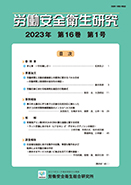Volume 16, Issue 1
Displaying 1-12 of 12 articles from this issue
- |<
- <
- 1
- >
- >|
preface
-
Article type: preface
2023Volume 16Issue 1 Pages 1-2
Published: February 28, 2023
Released on J-STAGE: February 28, 2023
Download PDF (573K)
original article
-
Article type: original article
2023Volume 16Issue 1 Pages 3-10
Published: February 28, 2023
Released on J-STAGE: February 28, 2023
Advance online publication: October 27, 2022Download PDF (762K) -
Article type: original article
2023Volume 16Issue 1 Pages 11-27
Published: February 28, 2023
Released on J-STAGE: February 28, 2023
Advance online publication: December 22, 2022Download PDF (1018K)
-
2023Volume 16Issue 1 Pages 29-43
Published: February 28, 2023
Released on J-STAGE: February 28, 2023
Advance online publication: January 13, 2023Download PDF (1227K)
brief report
-
Article type: brief report
2023Volume 16Issue 1 Pages 45-49
Published: February 28, 2023
Released on J-STAGE: February 28, 2023
Advance online publication: January 11, 2023Download PDF (1025K)
research report
-
Article type: research report
2023Volume 16Issue 1 Pages 51-64
Published: February 28, 2023
Released on J-STAGE: February 28, 2023
Advance online publication: October 07, 2022Download PDF (1052K) -
Article type: research report
2023Volume 16Issue 1 Pages 65-70
Published: February 28, 2023
Released on J-STAGE: February 28, 2023
Advance online publication: January 14, 2023Download PDF (1038K) -
Article type: research report
2023Volume 16Issue 1 Pages 71-82
Published: February 28, 2023
Released on J-STAGE: February 28, 2023
Advance online publication: January 14, 2023Download PDF (1100K)
research introduction
-
Article type: research introduction
2023Volume 16Issue 1 Pages 83-86
Published: February 28, 2023
Released on J-STAGE: February 28, 2023
Advance online publication: January 23, 2023Download PDF (4466K) -
Article type: research introduction
2023Volume 16Issue 1 Pages 87-92
Published: February 28, 2023
Released on J-STAGE: February 28, 2023
Advance online publication: January 26, 2023Download PDF (1081K) -
Article type: research introduction
2023Volume 16Issue 1 Pages 93-98
Published: February 28, 2023
Released on J-STAGE: February 28, 2023
Advance online publication: February 10, 2023Download PDF (944K) -
Article type: research introduction
2023Volume 16Issue 1 Pages 99-102
Published: February 28, 2023
Released on J-STAGE: February 28, 2023
Advance online publication: January 25, 2023Download PDF (845K)
- |<
- <
- 1
- >
- >|
